ENTS,
This is an update to an earlier post from 2/2006 concerning a
small old
growth area on the edge of Conneaut Marsh, known locally as the
Great
Geneva Marsh, approximately 7 miles from the I-79 Meadville
exit:
http://www.nativetreesociety.org/fieldtrips/penna/tryon_weber.htm
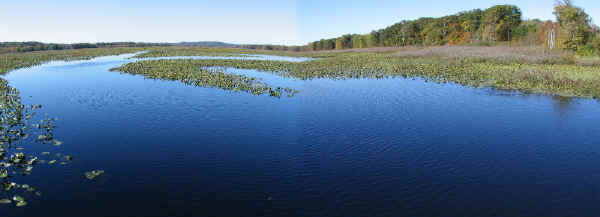
Conneaut Marsh west view |

Conneaut Marsh west view 2 |
I have visited the area several times now over the last year and
briefly
reported on it at the Fall ENTS Rendezvous in Holyoke. It is a
very
interesting site to me. Yes, it is small, only 3.6acres, but
contains
what I believe are some very old trees. The following 7 species
should
easily surpass 150 years in age:
Black oak
Pin oak (not in above old growth area, but in nearby stand along
marsh
edge)
N. red oak
Swamp white oak
White oak
Am. Beech
Black gum

American Beech |
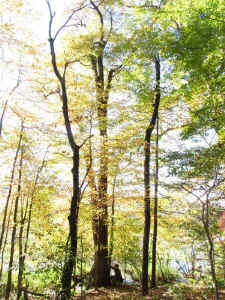
Black Gum |
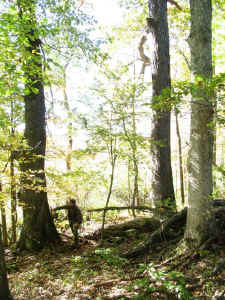
Black oak |

Red Oak snag |
Some species like the white, black, and N. red oak should easily
make
200 years, with white oak possibly surpassing the 300 year mark.
The
site is unique in that it is adjacent to an old canal towpath
that ran
along the edge of this long marsh. Why this small section was
left
spared is still currently a mystery to me. A nearby resident who
attended one of my interpretive hikes at Cook Forest told me of
a stand
on the northwestern edge of the swamp that reminded him of my
description of this area. Who knows what else is hiding in
various
state and private holdings in the area. I’ve only surveyed
about 1 mile
of the northern side of the marsh on State Game Lands property.
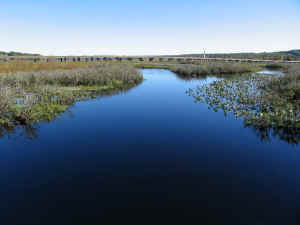
Conneaut Marsh east view |
The Conneaut Marsh averages close to ˝ mile wide, being just
over 1 mile
across at its widest point, and 12.3mile long. It is home to
some very
interesting and rare critters like the Eastern massassagua
rattlesnake,
Am. Bittern, and clapper rail.
The history of the swamp goes well back before the French &
Indian War
era of the 1750’s. Natives had old trails around it, or cut
through it
at its northern end where town of Conneaut Lake now stands. North
of
Conneaut Lake, another swamp forms which is named the Pymatuning
Marsh.

Oak escarpment |
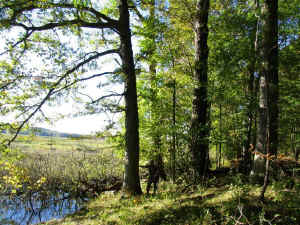
Conneaut Marsh Window |
For me, it was the first time I was able to measure pin oak in
its
natural setting. A select few pin oak on the
edges of the marsh
appeared very old with low drooping twisted limbs that resembled
barbwire. They were also difficult to reach. Most being on
hummocks
located on the edge of standing water in the marsh. The hummocks
weren’t too far from dry land, say about 100 yards, but
traveling those
100 yards was quite the challenge with having to pass through
the high
tangled mess of shrubs, reeds, mud holes that’ll easily suck
you in up
to your thighs, and swarms of mosquitos. Carl & Tony… this
place would
definitely rate a high MI (Mutiny Index) from our spouses and
girlfriends. This trip is not for the faint of heart…
I’ve also had the opportunity to fish part of the area. The
color of
the water in the entire marsh is a very dark tea color. It’s
probably
the best place to fish for bowfin in the entire state. Bowfin
are a
very odd looking fish. The dorsal fin runs about 2/3 the length
of its
entire back, just about touching the tail fin. The tail fin is
rounded
and often has a dark spot near its top. The head is somewhat
flattened
and to me has a type of bullhead/eel/musky appearance. Its mouth
is
full of teeth, and is known to charge waders/swimmers when they
get too
close to their beds to the breeding season. They can become
quite
large, 3-5ft I’ve read in some sources.
http://www.glerl.noaa.gov/seagrant/GLWL/Fish/bowfin/snakeheadID.gif
http://www.dnr.state.md.us/fisheries/art2004/0616album/0616bowfin_ct.jpg
http://www.dgif.state.va.us/FISHING/srf-photos/State%20Record%20
Bowfin%20and%20Angler.jpg
They are a blast to catch, often breaking the surface of the
water many
times. The fight is similar to that of a lively smallmouth bass,
but
one that is grotesquely overweight. They are a protected species
in the
state. It’s a pity that many fisherman throw them on the bank
instead
of throwing them back in the water… the meat is said to have a
very poor
taste. They are a predator, and often times in a heavily fished
area,
they are sometimes the only fish you catch. Either fisherman
clear out
the desirables, or the bowfin clears out most of the other fish.
Just
watch when you go to take out the hook… just when you think
they’ve
given it their last burst of energy, beware… I caught one with
a double
treble hook Rebel crayfish lure. Let’s just say when the fish
shook
violently in my hand, one of the treble hooks let go of the fish
and
attached to me… which put me in a very precarious situation as
that now
the violently wiggling fish and I were BOTH attached to the same
lure.
My stepson thought the whole thing was quite amusing as he
watched me
remove the hook that attached me to the fish using his coveted
forceps,
darned if I’m not going to have to get myself one of those
things. I’ve
been ‘noodlin’ long enough!
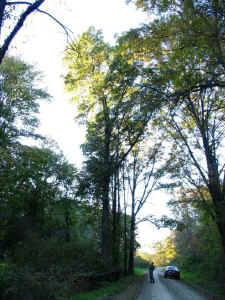
Scarlet Oak Champ 8.2 cbh x 108.7 |
Here’s an up to date list of all the trees I’ve measured
encompassing
both the 3.6acre old growth area, and other sites out of the old
growth
area along the towpath and adjacent 1 mile length of surveyed
marsh.
The cottonwood from an earlier post actually turned out to be a
black
gum! The bark was so deeply furrowed during the January 2006
trip to
the area that I mistook it for cottonwood. It wasn’t until my
October
2006 trip that I was able to observe the tree with its leaves.
The tree
had the appearance of great age and was right on the edge of
standing
water.
Species CBH Height Comments
Am. Beech 9.9 78.1+
Bitternut hickory 3.6 68.1
Black gum 8.5
(2x) 69.2
Black oak 13 N/A
Black oak 10.1 78.1+
Black oak 5.4 82.3+
Black oak 13.9 84.1+
Black walnut ~10 N/A based
covered with
multiflora rose, sorry Bob, didn’t bring my flack suit that
day
Black walnut 3.6 78.1+
Black walnut 6.7 84.1+
Cucumbertree 2.7 66.6
E. hophornbeam 2.6 46
Green ash ~4.9 75.1+
Green ash 5.8 78.1+
N. red oak 12.5 snag
N. red oak 13.5 snag
N. red oak 11.7 84.1+
N. red oak 11.4 87.1+
N. red oak 11.6 90.1+
N. red oak 11 93.1+
N. red oak 12.2 93.1+
N. red oak 9.6 100.6
Pin oak 5.4 69.1+
Pin oak 7.8 72.1+
Pin oak 3.7 75.8
Pin oak 5.5 78.1
Pin oak 5.6 84
Pin oak 5.8 91.7+
Pin oak 8.5 97.1
Red maple 3.2 84.1+
Scarlet oak N/A
(2x) 93.1+
Scarlet oak 8.2 108.7
Shagbark hickory 3.6 80.2
Shagbark hickory 3.3 81.9
Shagbark hickory 7.8 86.2
Shagbark hickory 3.8 87.1+
Shagbark hickory 8.3 89.7
Silver maple 3.6 72.1+
Swamp white oak 3.1 71.8+
Swamp white oak 7.7 72.3
Swamp white oak 8.2 87.1+
White oak 10.8 N/A
White oak 11.4 69.1+
White oak ~11.6 78.1+
White oak 11 87.1+
White oak 9.2 90.1+

Bee Tree |
A number of large ancient oaks in this area, at least 1 white
oak and 4
N. red oaks, had paper wasp nests either hanging from them, or
had nests
within them. I got to the point where I had to approach all
large and
old trees with caution. Sometimes I was warned of hives by the
droan of
bees, sometimes by the smell of sweet honey in the air. Before I
learned to be cautious, I almost walked straight into a hanging
wasp
nest as I snaked the D-tape around the tree. God was definitely
looking
out for me that day.
Most trees were not exceptional in height, but were remarkable
to me in
girth and age in regards to bark, crown, and butt swell
appearance. The
Conneaut Marsh Rucker Index follows:
Species CBH Height RI
Scarlet oak 8.2 108.7 90.37
N. red oak 9.6 100.6
Pin oak 8.5 97.1
White oak 9.2 90.1+
Shagbark hickory 8.3 89.7
Swamp white oak 8.2 87.1+
Black oak 13.9 84.1+
Black walnut 6.7 84.1+
Red maple 3.2 84.1+
Am. Beech 9.9 78.1+
Green ash 5.8 78.1+
All in all, the small old growth area is a very interesting site
to
explore and easy to find. If you can ID old growth from crowns
as you
drive, you should be able to see this site as I did right from
the
highway, especially when the leaves are off the trees.
Directions:
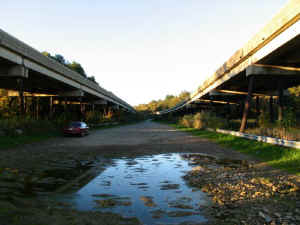
I-79 North View |
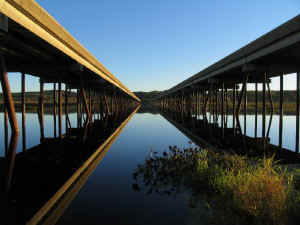
I-79 south view |
From I-79 exit 35 interchange to RT285W
RT285W to RT19N (as you drive RT19 across the marsh, the I-79
bridge is
parallel to your right (east))
After you cross the marsh, old growth and parking area are
immediately
to the left (west side of road), if you went up the hill, you
went too
far.
Dale
|